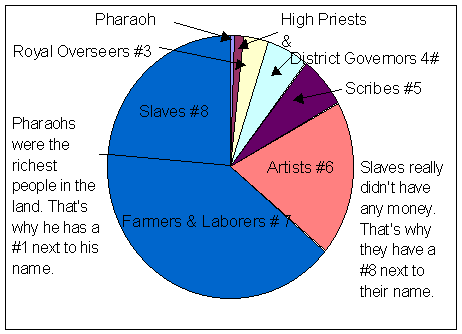Ancient Egypt had a well-developed economy. It had features of a planned Egyptian Economy. As money was not invented, barter system prevailed in buying and selling commodities. The cost was measured in a Deben, a copper weight of .5 ounces.
 Ancient Egypt was basically what is called a “supply state.” Products for consumption were delivered to state or temple institutions, which in turn distributed food and other goods to the population.Jobs in Ancient Egypt included government officials, soldiers, scribes, doctors, merchants, dancers, fishermen, hunters, bakers, carpenters, coffin-makers, spinners, weavers, jewelers, pyramid builders, Egyptian artists, and farmers.
Ancient Egypt was basically what is called a “supply state.” Products for consumption were delivered to state or temple institutions, which in turn distributed food and other goods to the population.Jobs in Ancient Egypt included government officials, soldiers, scribes, doctors, merchants, dancers, fishermen, hunters, bakers, carpenters, coffin-makers, spinners, weavers, jewelers, pyramid builders, Egyptian artists, and farmers.
Egyptian Economy Factor
Agriculture
Most Egyptians were farmers. The river Nile encouraged agriculture by providing a source of irrigation and also fertile black soil. Agriculture created most of Egypt’s wealth. Grain, vegetables, fruit, cattle, goats, pigs and fowl were grown, and fish from the Nile were caught, and eventual surpluses, after deduction of the various taxes, were sold on the markets. The main crops grown in Egypt were wheat, barley, lettuce, beans, onions, figs, dates, grapes, melons, and cucumbers. The pharaoh was the controller of the jobs.
Two commonly used measures of value were applied to determine the price of goods. One was the “heqat” measure, which developed from cereal farming and was used to determine the number of goods given as wages. The other was “shat,” which stood for an absolute measure of value.
Employees
 The land was reassigned and re-measured by officers and state employees, after every inundation based on past assignments. They assessed the expected crops, collected part of the produce as taxes, stored and redistributed it to those on the state’s pay lists. Storage and redistribution were generally done on a local basis. Regional facilities provided produce in case there was a shortfall in one of the local centers.
The land was reassigned and re-measured by officers and state employees, after every inundation based on past assignments. They assessed the expected crops, collected part of the produce as taxes, stored and redistributed it to those on the state’s pay lists. Storage and redistribution were generally done on a local basis. Regional facilities provided produce in case there was a shortfall in one of the local centers.
Production
After the taxes were paid, domain administrators and successful householders stored surpluses for future use or exchanged them by barter on the market. The percentage of products and even manufactured goods which reached markets was probably small.
It may have been of marginal importance to the survival of the individual producer, but provided part of the economic (Egyptian Economy) base for the developing Egyptian high culture.
There were no legal restrictions on the economic (Egyptian Economy) activity of women in Ancient Egypt. Most of the contracts and business papers we have found bear men’s names, but there are enough legal documents of all types with the names of women that we can be certain their rights were more than merely theoretical.
Trade started in the fourth century BC. Items brought from other countries were goods like silver, iron, cedar logs, horses, ivory, copper, cattle, leopard skins, and spices. The main products brought from Egypt were gold and other minerals, wheat, barley, and papyrus sheets. Sailors on the trading ships were paid in grain.
Much of the trade beyond local exchanges is thought to have been in the hands of wholesale merchants acting for the crown or the great temple estates. The extent to which private individuals were involved in trading cannot be estimated.
Market forces seem to have played a role above all during the periods when the administration broke down.
Major changes to the early barter system began to occur only with the influx of foreigners and the introduction of coined money in the Late Period.
